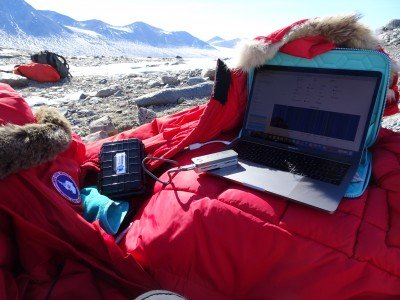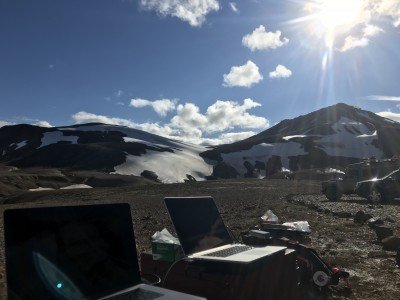
Field Sites
Antarctica
The lab’s had the chance to take part in two recent expeditions to Antarctica, in 2016 to the Dry Valleys in investigate cell survival in ancient paleolakes, and in 2018 to study Lake Untersee, a permanently ice-covered lake in Queen Maud Land with among the highest naturally-occurring levels of methane on the planet. These remote and challenging places provide insights not only into the limits of life on our planet but also how to go about detecting life on Mars and ocean worlds like Europa and Enceladus.
Iceland
Sarah first visited the acid salt lakes of the Yilgarn Craton of Western Australia as a student at MIT, and the lab’s returned three times since, working with colleagues Kathy Benison, Melanie Mormile, and Bethany Ehlmann to understand mineral biosignatures as well as biomarker preservation in this analog environment for early Mars. Sedimentary strata on the red planet often contain a mix of sulfates, iron oxides, chlorides, and phyllosilicates, a mineral assemblage unique on Earth to acid brine environments.
Atacama
In 2017, the lab set off for the Atacama Desert to investigate its incredibly arid soils, among the leanest in the world in terms of biomass. We completed a series of nanopore field sequencing runs and collected diagenetic gypsum veins for biosignature analyses, results that Maggie presented at the Lunar and Planetary Science Conference last year!
Idaho
Lava tubes found in Craters of the Moon National Monument and Preserve in Idaho are important analogs for Martian basalts, and we teamed up with NASA’s FINESSE and BASALT projects in 2016, 2017, and 2018 to probe microbial community structure and function in these unique environments, as well as biosignature production and preservation (Elena’s manuscript, supported by a Lewis and Clark Award, is forthcoming). With Chloe’s help, we’ll be expanding our lava tube work to Kilauea this summer!
Western Australia
Sarah first visited the acid salt lakes of the Yilgarn Craton of Western Australia as a student at MIT, and the lab’s returned three times since, working with colleagues Kathy Benison, Melanie Mormile, and Bethany Ehlmann to understand mineral biosignatures as well as biomarker preservation in this analog environment for early Mars. Sedimentary strata on the red planet often contain a mix of sulfates, iron oxides, chlorides, and phyllosilicates, a mineral assemblage unique on Earth to acid brine environments.
New Zealand
The lab’s also been investigating the nature and distribution of organic molecules in New Zealand sinters, as characterizing the preservation potential of silica-rich rocks (including hot spring deposits from different fluid compositions) can help us improve biosignature detection by future Martian rovers. With support from a Lewis and Clark Award, Maeva’s been focusing on five geothermal fields in the Taupo Volcanic Zone with physical and chemical variabilities, analyzing their lipid biomarkers as well as the types of signals that can be recovered using flight-like approaches (i.e. the pyrolyzer-gas chromatograph-mass spectrometer instruments SAM and MOMA on the Curiosity and Exomars2020 rovers).





